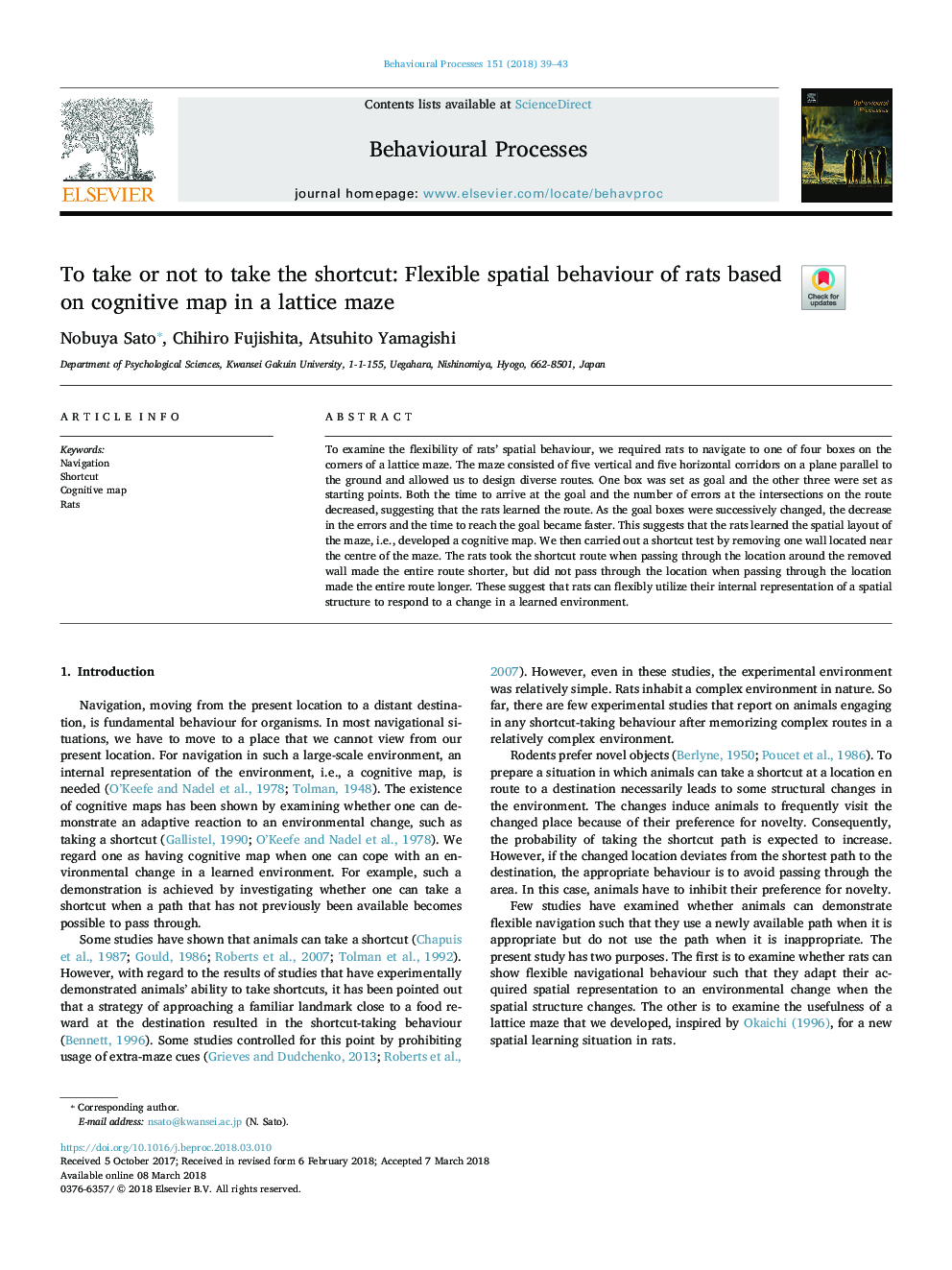| کد مقاله | کد نشریه | سال انتشار | مقاله انگلیسی | نسخه تمام متن |
|---|---|---|---|---|
| 8496964 | 1553130 | 2018 | 5 صفحه PDF | دانلود رایگان |
عنوان انگلیسی مقاله ISI
To take or not to take the shortcut: Flexible spatial behaviour of rats based on cognitive map in a lattice maze
ترجمه فارسی عنوان
برای گرفتن یا عدم استفاده از میانبر: رفتار مکانی انعطاف پذیر موش های مبتنی بر نقشه شناختی در یک پیچ و خم شبکه
دانلود مقاله + سفارش ترجمه
دانلود مقاله ISI انگلیسی
رایگان برای ایرانیان
کلمات کلیدی
جهت یابی، میانبر، نقشه شناختی، موش
ترجمه چکیده
برای بررسی انعطاف پذیری رفتار فضایی موش، ما موش ها را برای حرکت به یکی از چهار جعبه در گوشه های یک پیچ و تاب مشبک مورد نیاز داشتیم. این پیچ و خم شامل پنج عمودی و پنج راهرو افقی در یک هواپیما موازی با زمین بود و ما را قادر به طراحی مسیرهای متنوع کرد. یک جعبه به عنوان هدف تعیین شد و سه نفر دیگر به عنوان نقطه شروع تعیین شدند. هر دو زمان برای رسیدن به هدف و تعداد اشتباهات در تقاطع ها در مسیر کاهش می یابد، که نشان می دهد که موش ها مسیر را فرا گرفته اند. به عنوان جعبه هدف به طور متوالی تغییر، کاهش خطا و زمان برای رسیدن به هدف سریع تر شد. این نشان می دهد که موش ها طرح فضایی پیچ و خم را آموختند، یعنی یک نقشه شناختی ایجاد کرد. سپس یک تست میانبر را با حذف یک دیوار در نزدیکی مرکز پیچ و خم انجام دادیم. موش ها هنگام عبور از محل اطراف دیوار برداشته مسیر کوتاهی را طی کردند و کل مسیر را کوتاه تر کردند اما در هنگام عبور از محل، تمام مسیر را طولانی تر گذراند. این نشان می دهد که موش ها می توانند به طور انعطاف پذیری از نمای داخلی خود از یک ساختار فضایی برای واکنش به تغییر در یک محیط یاد گرفته استفاده کنند.
موضوعات مرتبط
علوم زیستی و بیوفناوری
علوم کشاورزی و بیولوژیک
علوم دامی و جانورشناسی
چکیده انگلیسی
To examine the flexibility of rats' spatial behaviour, we required rats to navigate to one of four boxes on the corners of a lattice maze. The maze consisted of five vertical and five horizontal corridors on a plane parallel to the ground and allowed us to design diverse routes. One box was set as goal and the other three were set as starting points. Both the time to arrive at the goal and the number of errors at the intersections on the route decreased, suggesting that the rats learned the route. As the goal boxes were successively changed, the decrease in the errors and the time to reach the goal became faster. This suggests that the rats learned the spatial layout of the maze, i.e., developed a cognitive map. We then carried out a shortcut test by removing one wall located near the centre of the maze. The rats took the shortcut route when passing through the location around the removed wall made the entire route shorter, but did not pass through the location when passing through the location made the entire route longer. These suggest that rats can flexibly utilize their internal representation of a spatial structure to respond to a change in a learned environment.
ناشر
Database: Elsevier - ScienceDirect (ساینس دایرکت)
Journal: Behavioural Processes - Volume 151, June 2018, Pages 39-43
Journal: Behavioural Processes - Volume 151, June 2018, Pages 39-43
نویسندگان
Nobuya Sato, Chihiro Fujishita, Atsuhito Yamagishi,
